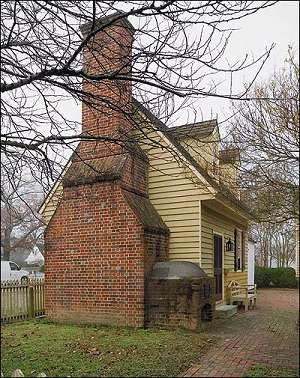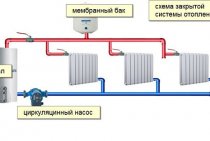Advantages and disadvantages of stove heating at home
Not always the owner of the house has the opportunity to conduct a gas main. This may be due to its remoteness or high financial costs. In this case, you can consider the design of the heating system for a two-story house using a stove.
A feature of this type of heat supply is the ability to use almost any type of solid fuel. Modern projects of houses with individual heating from a stove are designed for firewood, coal, peat, etc. However, not only this fact is the main one when choosing this type of heat supply. The owner must take into account such nuances that the project of a rural house with stove heating will entail:
- Distribution of heat throughout the building. If it does not provide for water heating, air heating will occur only from the stove;
- Low efficiency - up to 80%. Some of the thermal energy will be spent on heating the surface of the furnace. This applies to both brick and steel (cast iron) structures;
- Ensuring the safety of the heat supply lies only with the owner of the cottage. A typical gas heating project for a two-story house is preliminarily agreed with government services. For furnace heating, this is not necessary. Therefore, only the owner of the building is responsible for safety and quality;
- You should think in advance about the location of the furnace in the house. Heat from it should be evenly distributed throughout all rooms.
The last point is very important, since the designs of houses with stove heating must take into account not only the characteristics of the building (thermal insulation, relative humidity, etc.), but also the distribution of circulating air flows. Most often, the stove is located in the center of the house, but this is not the only possible heating option.
It's time to start the actual project.
When designing a furnace, it is worth bearing in mind that all the details recommended in this matter have long been explained in SNiP 2.04.05-91. Therefore, if there is a desire to delve into the recommendations and manuals thoroughly, start dancing from the stove, that is, it makes sense to deal with this particular document.
So, for example, the above sanitary norms and rules recommend installing stove heating in a wooden house only if the building is not higher than two floors in height, not counting the basement. Fire safety, according to these recommendations, is achieved by a number of measures, in particular, for example, the surface of the furnace should not heat up above one hundred and twenty degrees.
Advantages and disadvantages
The kiln laying process
The benefits include:
- The device of the stove in the house does not require significant financial investments; it is assembled relatively quickly and simply.
- Very often, the stove is combined with a fireplace, thanks to which the interior acquires an additional zest, and the house is always dry and warm.
- Stove heating with live fire can create a unique atmosphere of coziness and comfort in a country cottage, which cannot be achieved using any other heating device.
- Firewood is a relatively affordable and inexpensive fuel.
Main disadvantages:
- A real Russian oven requires a lot of space, because as you know, the larger the oven, the more heat it can give and the longer it will keep it.
- In order for the stove to warm up and begin to give off heat to the room, it needs quite a lot of time.
- The stove chimney is the main cause of heat loss in a country house.
- The efficiency of the stove is only 25 percent, this figure is very low compared to other heating systems.
It is very important, when constructing a furnace, to take into account all possible heat losses and the total area of \u200b\u200bheated housing. So, in order to heat a room of 35 sq.
meters need 1 square meter of the oven. So, for example, on average, for heating a country house, you need to spend about 550 kcal.
Weigh the pros and cons
We talked a little about "for". In addition to the emotional and sensual component described above, the advantages that stove heating of a private house undoubtedly has include independence from public utilities with their schedule for the seasonal distribution of heat to those in need and all sorts of possible failures of heating networks that can deprive your home of comfort for long days or even weeks. . The undoubted advantage of the village stove is also the creation of a healthy microclimate at home: villagers do not know what dry skin and brittle hair are in the autumn-winter-spring period, because good stove heating does not dry the air at home.
Design and device
The device and scheme of the furnace
Before proceeding directly to the creation of stove heating, you need to carefully study the material on the topic and develop its project, in which the location of the future stove is clearly indicated.
Experts believe that it should be located as close to the center as possible.
The front side of the oven, as a rule, is directed to the kitchen - it is great as a place for frying and cooking food. The back wall is designed to heat the rest of the house.
Most often, the stove is made of red brick, which is laid on a clay mortar. The main components of the Russian stove are:
- firebox;
- boilers;
- ash collection;
- flue pipes.
The heat source is fire, which burns in the lower part of the furnace and hot smoke, which goes through the boilers into the chimney.
Furnace heating of a country house
Each type of building needs an appropriate heater or heating system. Small garden houses with a wall thickness of no more than 25 centimeters can be heated by light frame stoves weighing up to 750 kilograms. With a small volume of bricks, the furnace and the room are quickly heated. It takes only 30-60 minutes for the heat transfer of such a furnace to exceed the heat loss of the room. In frame ovens, as a rule, there are no stoves. The purchased small cast-iron stove with a stove is connected to the frame stove, and the cooking process can last as long as the owner of the house wishes. Such furnaces are installed without a separate foundation. The stove is placed directly on a hard and stable floor. As for the pipe for such a furnace, it must be root and it needs a separate foundation or the pipe is built into the main wall.
Large country brick houses with a total area of one floor over 70 m2 can be well heated by a heat-intensive stove together with stove water heating. One heating or heating and cooking stove will not heat such a house.
Stove heating of a country house is an ancient way of heating a home and a very relevant topic if there is no gas in a country house. In this case, all roads are open to stove heating. This method of heating is simple and reliable. Various designs of furnaces that exist today can operate on various fuels. Firewood, coal, diesel fuel, used engine oil are used as fuel.
When choosing the design and power of the stove, take into account the fact that the stove should give out no less heat per unit of time than the room loses it in the same unit of time.
Furnaces are different in design. Wood-burning stoves have a direct firing method. Furnaces with such a firebox are called potbelly stoves and buleryan furnaces, which support long-term burning. Recently, preference has been given to metal furnaces. Such furnaces use the energy of combustion of fuel for heating as efficiently as possible.Well-established and reliable designs of such furnaces contribute to quick and trouble-free installation.
Furnace heating of a country house can become comfortable, taking into account all the nuances of your building.



